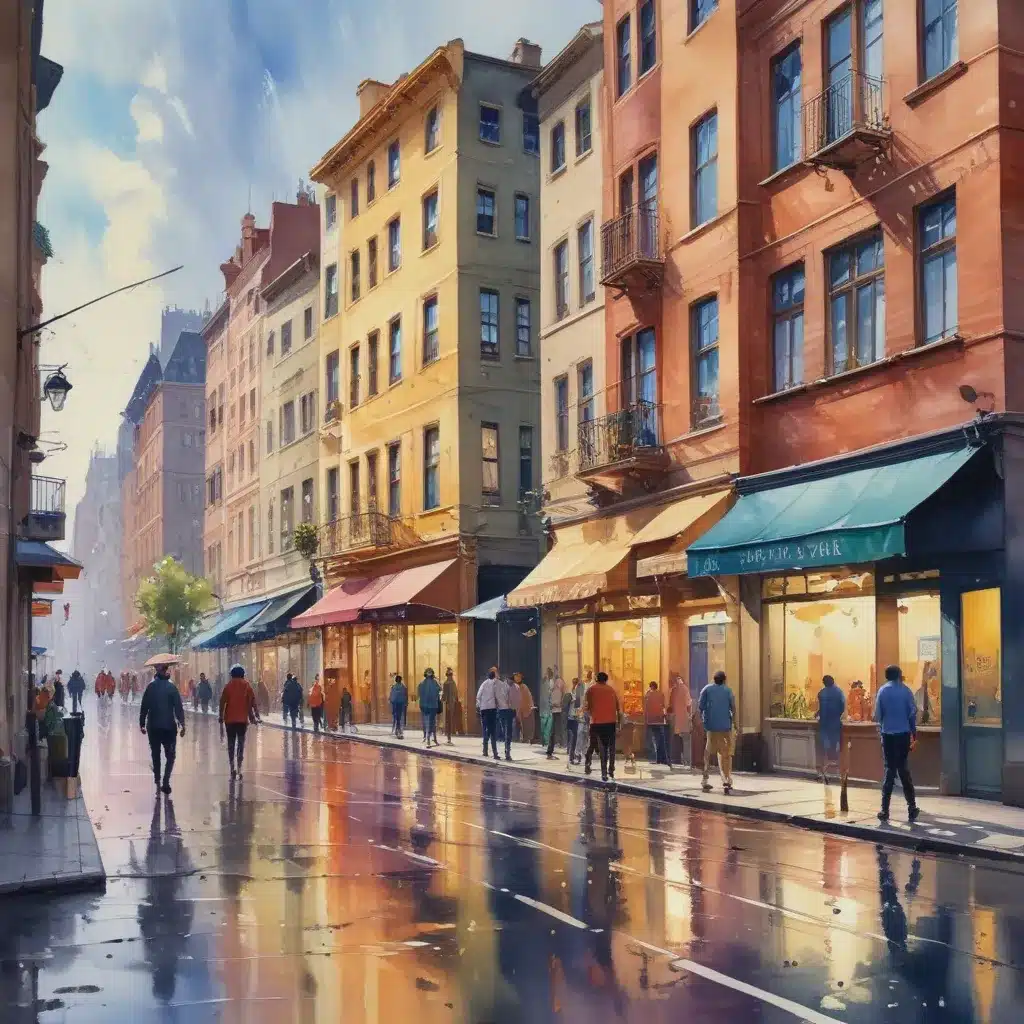
Bustling cityscapes, glowing streetlights, and the play of light and shadow—the dynamic energy of urban environments has long captivated artists, and watercolour is the perfect medium to capture this visual splendour. As an experienced art writer and creative consultant, I’ll share my top techniques for rendering vibrant, atmospheric urban scenes that practically leap off the page.
Mastering Watercolour for Urban Landscapes
Whether you’re a beginner or seasoned artist, watercolour can be a challenging yet immensely rewarding medium. Its fluid, unpredictable nature takes practice to control, but the luminous, spontaneous effects are hard to match. When painting city scenes, watercolour’s fluidity is a distinct advantage, allowing you to quickly lay down lively brushstrokes that capture the kinetic energy of urban life.
One of the keys to successful watercolour urban sketching is learning to embrace the medium’s natural unpredictability. Rather than fighting against the paint, learn to anticipate and work with watercolour’s unique flow and blending. Embrace happy accidents and use them to your advantage, whether it’s the soft, organic edges of a building or the unexpected patterns created by water beading on the page.
Watercolour also pairs beautifully with ink drawing, which can provide structure and definition to your compositions. Start with a confident ink outline, then let the watercolour wash bring the scene to life with vibrant colour and atmospheric effects. This combination of precision and fluidity is perfect for rendering the complex details of an urban landscape.
Painting the City in Light and Shadow
The interplay of light and shadow is integral to capturing the essence of a city scene. Strong, dramatic contrasts can transform the ordinary into the extraordinary, as Gareth Naylor so brilliantly demonstrates in his urban sketches.
Begin by observing how the light falls across buildings, streets, and people. Where are the bright, sunlit areas, and where do the shadows pool and deepen? Use this observation to guide your colour choices and brushwork. Opt for bold, high-contrast colours in the sunlit zones, and paint the shadows with a more muted, atmospheric palette.
As Naylor notes, the intensity of light in certain environments, like Japan, can be dramatically harsh, creating “almost black and white” scenes with extreme contrasts. Embrace this by using decisive ink linework to define the shadows, then layer watercolour washes to gradually build up depth and luminosity.
Shari Blaukopf’s urban winter scenes demonstrate how to skillfully balance light and shadow. Notice how she uses a cool, muted palette for the snow-covered roofs and streets, then lets the warm, glowing wall in the foreground pop against the surrounding coolness. This contrast draws the eye and creates a sense of depth and atmosphere.
Capturing the Bustling Energy of the City
City scenes are inherently dynamic, with a constant flux of people, vehicles, and activity. Watercolour is the perfect medium to convey this lively energy, thanks to its fluid, expressive brushwork.
When painting figures and movement, avoid overly detailed rendering. Instead, focus on capturing the essence of a scene with gestural, expressive marks. Use a combination of ink lines and watercolour washes to quickly suggest the form and movement of pedestrians, cyclists, and other urban denizens. Suhita Shirodkar’s vibrant sketches demonstrate this approach beautifully.
Pay close attention to how the light hits and interacts with the figures. Where do you see areas of bright, direct illumination contrasted with soft, shadowed forms? Use these observations to guide your colour choices and brushwork, creating a sense of depth and three-dimensionality.
Don’t forget to also include the inanimate elements that give a city scene its unique character.渲渲Render the textural qualities of brick, concrete, and metal with layered washes and sgraffito techniques. Capture the worn, weathered surfaces of sidewalks, roads, and building facades. These details will help ground your figures in a believable, immersive urban environment.
Practical Tips for Painting Vibrant City Scenes
Ready to start painting your own dynamic urban landscapes? Here are some practical tips to help you get started:
• Carry a portable painting kit: Pack a small watercolour sketchbook, a selection of high-quality watercolour paints, a few brushes, and a reliable pen or ink for sketching. This allows you to work on location, capturing the energy of the city as it unfolds around you.
• Observe and plan your composition: Take time to carefully observe the scene before you, noting the shapes, colours, and patterns that catch your eye. Sketch a quick compositional study, considering how you’ll arrange the various elements to create a compelling, balanced design.
• Embrace a limited palette: When painting urban scenes, a limited, harmonious colour palette can be incredibly effective. Try a triad of warm and cool colours, or experiment with a monochromatic scheme that showcases the play of light and shadow.
• Start with a strong ink drawing: As mentioned earlier, an confident ink outline can provide essential structure for your watercolour painting. Use your initial sketches to establish the key shapes, lines, and details, then let the watercolour bring the scene to life.
• Practice wet-in-wet techniques: Watercolour’s fluid, blending properties are perfect for capturing the soft, atmospheric effects of city light. Experiment with wet-in-wet washes, allowing the paint to flow and mix organically on the paper.
• Don’t be afraid of shadows: Embrace the rich, dark tones of shadow areas, using them to create depth and drama in your compositions. Observe how the shadows shift and morph throughout the day, and use this knowledge to inform your painting process.
Whether you’re new to urban sketching or a seasoned watercolour artist, I hope these techniques and insights will inspire you to explore the vibrant, ever-changing world of the city through the medium of paint. Remember, the key is to observe, experiment, and embrace the spontaneity of watercolour—the results will be truly captivating. Happy painting!
Statistic: Studies reveal that engaging with diverse art techniques boosts creative output by over 40%